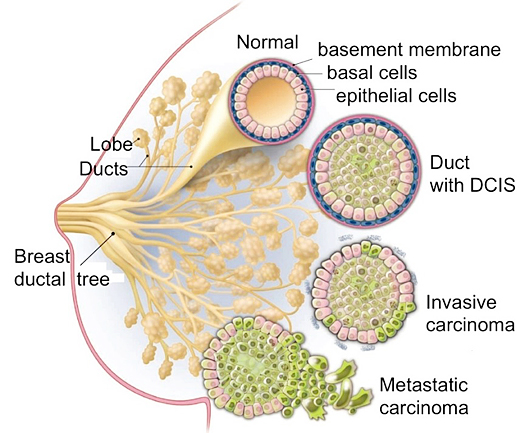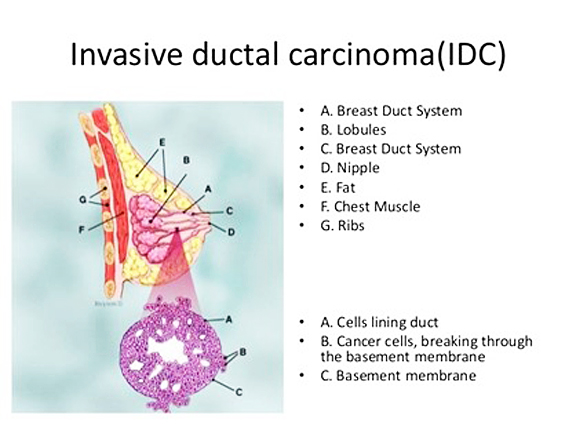Identifying the warning signs and embracing prevention as a frontline strategy against breast cancer.
Breast cancer, a complex and often insidious disease, typically initiates its journey within the tiny breast glands known as lobules, responsible for producing milk, or in the intricate network of ducts that ferry this vital substance to the nipple.
Over time, a few ordinary cells may undergo transformation, progressing to a precancerous state. If left unaddressed, this transformation can culminate in the development of cancerous cells.
As the disease takes hold, it has the potential to expand within the breast and potentially extend its reach to neighbouring lymph nodes in the armpits or neck, or it may embark on a more perilous journey through the bloodstream to distant organs.

Breast cancer’s influence can extend further as it infiltrates the surrounding breast tissue, impacting structures like the skin, chest wall, or even the bones. These advanced stages are referred to as breast secondaries.
The tempo at which various types of breast cancer grow and disseminate can vary significantly, with some progressing gradually over several years, while others exhibit a more rapid and aggressive nature.
Sharing this information was consultant medical oncologist at The Brunei Cancer Centre, Pantai Jerudong Specialist Centre (PJSC) Dr Raden Mas Jefri bin Raden Mas Ismail in his paper, Raising Awareness on Breast Cancer, in conjunction with Breast Cancer Awareness Month.
As part of a worldwide initiative to promote breast cancer awareness, the month of October has been designated as Breast Cancer Awareness Month, often symbolised by the colour pink.
The dedicated month focuses on essential aspects such as early detection and recognising the signs and symptoms associated with the disease.

WHERE BRUNEI STANDS
Breast cancer has the potential to impact one out of every 12 women in Brunei in their lifetime. Over the past decade, the rate of breast cancer in Brunei has risen, with more than 120 new cases each year compared to under 100 cases annually a decade ago.
He said in terms of prevalence in the region, Brunei has the second-highest breast cancer incidence for its population size, with Singapore leading the list at just under one in 10 women.
Although breast cancer predominantly affects women, it’s worth noting that approximately one per cent of the cases are men.
Interestingly, women are more likely to develop cancer than men, contrasting other Southeast Asian countries where cancer is more prevalent in men.
The contrast can be attributed in part to the higher incidence of breast cancer, which predominantly affects women.

Regarding cancer-related fatalities, breast cancer is the primary cause of death among Bruneian women and the third leading cause of cancer-related deaths overall, after lung and bowel cancers, which affect both genders equally.
Brunei also records a higher mortality rate for breast cancer compared to other high-income countries.
A significant proportion of new breast cancer cases in Brunei are still diagnosed at an advanced stage, highlighting the need for early detection and intervention.
“Early detection and access to optimal treatment are the keys to reducing breast cancer-related mortality,” said Dr Raden Mas Jefri.
In November 2019, the Ministry of Health initiated breast mammography screening for women aged 40 and above.
In collaboration with non-governmental organisations (NGOs) and the private sector, campaigns were carried out to heighten awareness on breast cancer and encourage women, who are at risk or experiencing symptoms of breast cancer, to seek early medical attention.
“Despite efforts to improve public awareness, majority of new breast cancer cases diagnosed recently are still found at advanced stages, thus potentially poorer outcome and morbidity such as premature death,” Dr Raden Mas Jefri added.
ARE BREAST CANCER CASES ON THE RISE?
The unequivocal answer is yes. The increase is attributed to several factors, primarily shifts in the prevalence of risk factors.
These factors encompass a higher incidence of reproductive and hormonal risk elements, such as early menstruation, delayed menopause, later age at first childbirth, having fewer children, reduced breastfeeding, menopausal hormone therapy, oral contraceptive usage, and lifestyle-related risk factors like alcohol consumption, excessive body weight, and physical inactivity.
Moreover, the expanded adoption of mammographic screening has notably contributed to better detection of breast cancer cases. Thankfully, breast cancer treatment has high chances of success when detected early.
Localised cancer, or when the cancer is confined to the breast, can typically be addressed through surgical intervention to prevent further spread.

ULTIMATE TREATMENT GOAL
In many cases, a combination of chemotherapy before and after surgery not only helps eliminate the cancer but also allows for breast conservation, preserving a portion of the breast instead of necessitating a full mastectomy.
However, as the cancer advances and begins to spread, the treatment approach becomes more complex.
Although the prospects of a complete cure diminish, modern breast cancer therapies are often capable of controlling the disease over an extended period. However, said the oncologist, “The best form of fighting breast cancer is through prevention”.
BREAST CANCER SYMPTOMS
It is important to note that early-stage breast cancer often remains asymptomatic and is typically detected through screening.
However, when symptoms manifest, they may include the presence of a lump or thickened area in or near the breast or underarm that persists beyond the menstrual cycle.
It may also include detection of a mass or lump, regardless of its small size, even as small as a pea; changes in the size, shape, or contour of the breast; nipple discharge, which may be bloody or clear; alterations in the skin of the breast or nipple, such as dimpling, puckering, scaliness, or inflammation; the development of redness on the breast or nipple; changes in the shape or position of the nipple; identification of an area that appears distinct from any other part of either breast; or the presence of a hard, marble-sized spot beneath the skin.
DISCOVERING A LUMP: NOW WHAT?
Noticing a change or lump in your breast or nipple should not immediately lead to anxiety or hasty conclusions. In fact, most breast lumps are benign, meaning they are non-cancerous.
Younger women, in particular, often experience breast lumps linked to their menstrual cycles, which tend to vanish by the end of their cycle.
Therefore, it’s prudent to avoid breast self-examination during menstruation. However, if you do come across a lump or detect any alteration in your breast or underarm area, it’s advisable to schedule for a check-up at a health clinic.
MAMMOGRAPHY IN BRUNEI
Brunei introduced screening mammography for breast cancer.
The specialised medical imaging technique utilises a low-dose x-ray system to provide insights into breast tissue. Screening mammography is designed for women of certain age groups, enabling early detection of breast cancer, when it is the most treatable. – Izah Azahari







